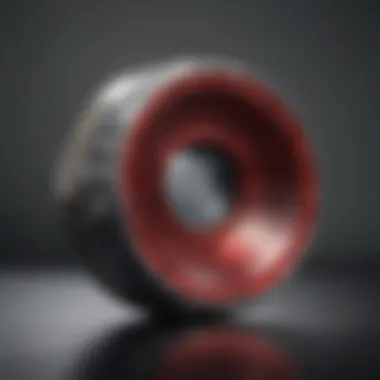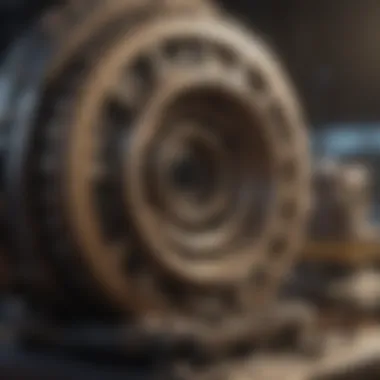Unveiling the Secrets of Lapidary Polishing Equipment: A Comprehensive Guide


Rock and Fossil Identification
Lapidary work entails the identification of various types of rocks and fossils, a crucial starting point for enthusiasts and professionals. Understanding the characteristics to look for in these specimens is vital for successful polishing endeavors. This process involves using specialized tools designed for precise identification tasks, such as magnifying lenses, UV lights, and scratch testers. The mastery of rock and fossil identification sets the foundation for the subsequent stages of lapidary polishing.
Collecting Tips and Techniques
To excel in the world of lapidary polishing, aspiring collectors must adhere to best practices in acquiring precious specimens. This includes knowing where to locate prime collecting sites, which are often geologically rich in diverse rocks and fossils. Safely extracting specimens without causing damage requires delicate handling and the use of appropriate digging and extraction tools. By following these collecting tips and techniques diligently, enthusiasts can amass a valuable collection for their lapidary pursuits.
Preservation and Display
Preservation techniques play a pivotal role in maintaining the quality and integrity of rocks and fossils over time. Implementing proper storage methods, such as using acid-free paper and containers to prevent deterioration, is essential. Moreover, creative display ideas can enhance the aesthetic appeal of collections, ranging from custom-built shelving units to thematic showcases that highlight the geological diversity of specimens. Balancing preservation with creative display allows collectors to showcase their finds while safeguarding their longevity.
Geological Insights
Delving into lapidary work unveils fascinating geological insights concerning the formation and processes that shape rocks and fossils. Understanding geological formations provides context to the rocks and fossils being polished, offering a glimpse into their historical significance. Notable discoveries in the field of geology have further enriched the understanding of rock formations and fossilization processes, pushing the boundaries of scientific knowledge in this domain. By exploring these geological insights, enthusiasts can deepen their appreciation for the natural world and the treasures it holds.
Introduction to the World of Lapidary Polishing Equipment
Lapidary polishing equipment holds a pivotal role in the realm of gemstone refinement and emphasizes precision and finesse in the polishing process. The machines utilized in lapidary work are designed with intricate mechanisms to achieve optimal polishing results, catering to the discerning needs of both amateurs and skilled professionals. An understanding of the diverse range of equipment available in the market empowers enthusiasts to embark on a journey of creativity and craftsmanship in gemstone enhancement and rock polishing. Exploring the nuances of lapidary polishing equipment unveils a world where artistry meets technology, offering a myriad of possibilities to transform raw stones into gleaming treasures.
Understanding the Basics of Lapidary Polishing
Grinding vs. Polishing
The distinction between grinding and polishing lies in their fundamental objectives within the lapidary domain. Grinding involves the initial shaping and smoothing of gemstones or rocks, primarily focusing on rough material removal to achieve desired forms. Conversely, polishing accentuates the surface luster of the specimen, enhancing its visual appeal and reflective quality. Grinding is characterized by its abrasive nature, efficiently leveling surfaces, while polishing brings a glossy finish to the stone, intensifying its inherent beauty. Both processes synergize in the lapidary practice, combining technical proficiency with artistic vision to create stunning lapidary pieces that mesmerize with their finesse and elegance.
Key Components of Polishing Machinery
The core components of polishing machinery encompass essential elements that drive the precision and efficacy of the polishing process. From abrasive discs to polishing pads, each component plays a critical role in realizing the desired finish on gemstones and rocks. Understanding the nuances of key components such as the motor, polishing disc, and water system allows lapidary enthusiasts to optimize their polishing techniques, ensuring consistent and high-quality results. The interplay of these components harmonizes to deliver a seamless polishing experience, elevating the aesthetics of gemstones and rocks with a dazzling brilliance that captivates the beholder.
Types of Lapidary Polishing Machines
Rotary Tumblers
Rotary tumblers are renowned for their versatile capacity in polishing a wide array of gemstones and rocks with efficiency and precision. Their drum-like structure accommodates different polishing media, facilitating the gentle yet thorough polishing of specimens to impart a radiant sheen. The rotary tumblers' rotational motion ensures an even distribution of abrasives, resulting in uniform polishing across all surfaces of the gemstone or rock. This makes them a favored choice among lapidary enthusiasts seeking consistent and exquisite finishes in their polished creations.
Vibratory Tumblers
Vibratory tumblers stand out for their rapid and continuous vibrational action, which expedites the polishing process while retaining exceptional finish quality. The vibratory motion of these machines allows for intricate polishing of delicate or intricate gemstone shapes, ensuring a meticulous polish without compromising on efficiency. By harnessing the gentle yet effective vibrational energy, the vibratory tumblers offer a sophisticated polishing solution that caters to the diverse needs of lapidary artisans in achieving immaculate and flawless results.
Flat Lap Machines


Flat lap machines epitomize precision and control in the realm of lapidary polishing, providing a flat and level platform for polishing gemstones with unparalleled accuracy. Their rotating flat laps, coated with abrasive grits, enable artisans to achieve mirror-like finishes on gemstones by meticulously grinding and polishing their surfaces. The flat lap machines' versatility in accommodating different grit sizes empowers lapidary enthusiasts to progress from coarse grinding to fine polishing seamlessly, unlocking a spectrum of creative possibilities in shaping and refining gemstones with intricate detail and finesse.
Choosing the Right Polishing Equipment
Factors to Consider
When selecting polishing equipment, various factors come into play, influencing the choice of machinery based on individual preferences and project requirements. Factors such as the type of gemstones being polished, desired finish quality, and available workspace determine the most suitable polishing equipment for the task at hand. By considering these factors diligently, lapidary artisans can streamline their polishing process, ensuring optimal results that align with their creative vision and craftsmanship standards.
Best Practices for Selection
Adhering to best practices in the selection of polishing equipment is crucial for achieving consistent and superior polishing outcomes in lapidary work. Embracing best practices involves conducting thorough research on equipment specifications, seeking recommendations from experienced lapidary experts, and testing machinery performance before making a final purchase. By incorporating best practices in equipment selection, lapidary enthusiasts can navigate the expansive landscape of polishing equipment with confidence, fostering a productive and rewarding journey in the art of gemstone polishing and refinement.
Essential Tools for Lapidary Polishing The section on Essential Tools for Lapidary Polishing in this article delves deeply into the foundational components crucial for achieving exquisite results in lapidary work. Engaging with the theme of this meticulous craft, we unravel the significance of the essential tools, shedding light on their essential role in the lapidary polishing process. These tools, ranging from abrasive materials to auxiliary equipment, are pivotal in transforming rough stones into beautifully polished gemstones, making them indispensable for lapidary enthusiasts and professionals alike. Let's explore the intricate world of these essential tools and understand how they shape the art of lapidary polishing to attain perfection.
Abrasive Materials
Diamond Pads Diamond Pads stand as an epitome of precision and finesse in the realm of lapidary polishing. Their smooth surface and durability make them a popular choice among lapidary enthusiasts. The unique feature of Diamond Pads lies in their ability to achieve a mirror-like finish on gemstones and rocks, enhancing their aesthetic appeal. While Diamond Pads offer exceptional polishing results, their high cost can be a deterrent for beginners in the field of lapidary work. It is essential to note both the advantages and disadvantages of incorporating Diamond Pads into the lapidary polishing process to make informed decisions and optimize polishing outcomes.
Silicon Carbide Grit Silicon Carbide Grit emerges as a versatile abrasive material that plays a key role in the lapidary polishing process. Known for its hardness and fast-cutting abilities, Silicon Carbide Grit is a popular choice for initial shaping and grinding of gemstones. Its unique feature lies in its efficient performance on various types of stones, making it a versatile option in lapidary workshops. However, the abrasive nature of Silicon Carbide Grit can lead to faster wear and tear of equipment if not used with caution, indicating the need for proper maintenance and handling protocols. Understanding the advantages and disadvantages of Silicon Carbide Grit is fundamental in harnessing its potential for achieving desired polishing results effectively.
Polishing Compounds Polishing Compounds serve as the final touch in the lapidary polishing process, enhancing the luster and shine of gemstones. Their key characteristic lies in their ability to smooth out scratches and imperfections on stone surfaces, resulting in a flawless finish. Polishing Compounds are a beneficial option for achieving professional-grade polishing outcomes and are widely used in lapidary workshops. It is crucial to recognize the unique features of different Polishing Compounds and their respective advantages and disadvantages to select the most suitable one for specific lapidary projects. By understanding the nuanced nature of Polishing Compounds, lapidary enthusiasts can elevate their polishing techniques and produce exceptional gemstones of unparalleled quality.
Auxiliary Equipment
Water Systems Water Systems play a vital role in cooling and lubricating lapidary equipment during the polishing process. Their key characteristic of maintaining optimal operating temperatures ensures the longevity and efficiency of polishing machinery. Water Systems are a popular choice in lapidary workshops due to their ability to minimize friction and prevent overheating, contributing to enhanced polishing results. Despite their advantages, proper installation and maintenance of Water Systems are necessary to prevent leaks and ensure uninterrupted workflow in lapidary operations. Recognizing the advantages and disadvantages of Water Systems is essential for lapidary enthusiasts to maximize their usage and optimize the polishing process effectively.
Dust Collectors Dust Collectors are essential components that maintain a clean and safe working environment in lapidary workshops. their key characteristic lies in efficiently capturing and filtering dust particles generated during the polishing process, preventing respiratory issues and equipment damage. Dust Collectors are a popular choice among lapidary professionals for promoting workplace safety and cleanliness. However, regular maintenance and filter replacements are crucial to ensure the seamless operation of Dust Collectors and uphold workshop hygiene standards. Understanding the advantages and disadvantages of Dust Collectors is imperative for lapidary enthusiasts to implement effective dust control measures and prioritize the well-being of individuals in the workshop setting.
Protective Gear Protective Gear is a cornerstone of safety in lapidary workshops, safeguarding individuals from potential hazards during the polishing process. Their key characteristic of providing protection against abrasives, chemicals, and flying debris ensures the well-being of lapidary enthusiasts and professionals. Protective Gear is a must-have accessory for ensuring a secure working environment and preventing injuries in lapidary operations. While the advantages of Protective Gear are evident in enhancing workplace safety, proper selection and maintenance of gear are essential for optimal performance and comfort. Recognizing the advantages and disadvantages of different types of Protective Gear equips lapidary workers with the knowledge to prioritize safety measures and create a secure setting for engaging in lapidary polishing activities.
Maintenance and Care Tips Maintenance and Care Tips offer valuable insights into preserving the longevity and performance of lapidary equipment, ensuring seamless operations in the workshop. Their key characteristic lies in establishing regular cleaning and maintenance routines to prevent equipment malfunctions and prolong durability. By adhering to recommended Cleaning Procedures, lapidary enthusiasts can maintain the efficiency of their equipment and achieve consistent polishing results. Similarly, following Storage Recommendations aids in organizing tools and machinery systematically, reducing clutter and minimizing the risk of damage. Understanding the unique features of Cleaning Procedures and Storage Recommendations enhances the overall efficiency and safety of lapidary workshops, setting the foundation for a productive and well-maintained workspace.
Advanced Techniques and Applications
In this section, we delve into the crucial realm of advanced techniques and applications in the lapidary polishing arena. Understanding and mastering these advanced methods is essential for enthusiasts and professionals looking to elevate their skills and achieve impeccable results in gemstone and rock polishing. By honing these techniques, individuals can enhance the quality of their work and unlock exciting possibilities in shaping and refining precious stones.
Faceting and Cabbing
Precision Cutting
Precision cutting plays a pivotal role in the lapidary world, offering craftsmen the ability to create intricately shaped gemstones with unparalleled accuracy and detail. The key characteristic of precision cutting lies in its ability to achieve precise facets that reflect light in mesmerizing ways. This technique is highly favored in lapidary work due to its ability to enhance the brilliance and allure of gemstones. While precision cutting demands meticulous attention to detail, its advantages in enhancing gemstone aesthetics are undeniable, making it a popular choice among lapidary enthusiasts.


Gemstone Enhancement
Gemstone enhancement serves as a vital component of the lapidary process, allowing craftsmen to elevate the natural beauty of stones through various treatments. The primary characteristic of gemstone enhancement is its ability to enrich the color, clarity, and overall appearance of gemstones, adding value and allure. This technique is widely embraced in the lapidary community for its capacity to transform ordinary stones into extraordinary treasures. While gemstone enhancement offers significant benefits in enhancing aesthetic appeal, it's essential to weigh the advantages against any potential drawbacks to ensure ethical practices.
Specialized Finishing Methods
Polishing Spheres
Polishing spheres introduces a unique approach to finishing gemstones, providing craftsmen with the ability to create spherical shapes with a flawless, polished surface. The key characteristic of polishing spheres lies in its capacity to achieve smooth and uniform finishes on curved surfaces, enhancing the visual appeal of gemstones. This method is valued for its effectiveness in polishing rounded gemstones, achieving a lustrous sheen that captivates the eye. While polishing spheres offer remarkable advantages in intricate finishing, craftsmen must carefully consider the limitations and potential challenges associated with this technique.
Carving and Engraving
Carving and engraving represent intricate methods of adding artistic details and personal touches to gemstones. The distinguishing feature of this technique is its ability to sculpt elaborate designs and patterns onto gemstone surfaces with precision and finesse. Carving and engraving are favored choices in lapidary work for their ability to infuse unique character and narrative into gemstones, making them standout pieces. While these methods offer exceptional creative possibilities, craftsmen need to navigate the complexities of intricate detailing and the time-intensive nature of carving and engraving.
Industrial and Artistic Applications
Architectural Uses
The utilization of gemstones and rocks in architectural settings exemplifies the fusion of artistry and functionality, enhancing interior and exterior spaces with natural elegance. Architectural applications integrate gemstone accents into building facades, floors, and ornamentation, providing unique aesthetic appeal and tactile interest. The key characteristic of architectural uses lies in their ability to harmonize natural elements with contemporary design, fostering a sophisticated ambiance. While architectural applications offer diverse opportunities for creative expression, craftsmen must ensure compatibility with architectural requirements and durability considerations.
Jewelry Making
Jewelry making stands as a prominent domain within the lapidary field, where craftsmen craft exquisite pieces of wearable art using gemstones and rocks. The key characteristic of jewelry making is its emphasis on precision, design, and aesthetics, showcasing the allure of gemstones in wearable forms. Jewelry making represents a popular choice among lapidary enthusiasts for its ability to transform raw stones into stunning wearable pieces that adorn individuals with elegance. While jewelry making presents endless creative possibilities, craftsmen must navigate the challenges of crafting intricate designs and ensuring the structural integrity of jewelry pieces.
Safety Measures and Best Practices
In the realm of lapidary polishing equipment, the emphasis on safety measures and best practices stands as a crucial cornerstone to ensure a secure and efficient working environment. Given the intricacies involved in handling gemstones and rocks, a meticulous approach to safety is paramount. By prioritizing safety measures, lapidary enthusiasts and professionals can safeguard against potential hazards and enhance overall productivity.
Risk Assessment
Hazard Identification
Within the domain of risk assessment, hazard identification emerges as a pivotal focal point for maintaining safety standards in lapidary work. Effective hazard identification involves a comprehensive analysis of potential risks inherent in the polishing process, ranging from machine malfunctions to exposure to harmful substances. This proactive approach enables individuals to preemptively address dangers, thereby minimizing the likelihood of accidents and injuries. The systematic identification of hazards is instrumental in fostering a culture of workplace safety, serving as a proactive safeguard against unforeseen mishaps.
Protective Measures
The implementation of protective measures represents a proactive strategy to mitigate risks and ensure the well-being of individuals engaged in lapidary polishing activities. From the utilization of personal protective equipment to the enforcement of operational protocols, protective measures play a pivotal role in safeguarding against potential harm. By adhering to established safety guidelines and procedures, practitioners can effectively minimize risks and create a secure working environment conducive to optimal performance.
Workshop Safety Guidelines
Proper Ventilation


Proper ventilation stands as a critical component of workshop safety guidelines in lapidary polishing. Adequate ventilation systems facilitate the removal of harmful dust particles and fumes generated during the polishing process, thereby reducing the risk of respiratory issues and enhancing air quality. The strategic design and implementation of ventilation solutions contribute to a healthier workspace, promoting long-term occupational safety and well-being.
Emergency Protocols
Establishing stringent emergency protocols is essential for preparing against unforeseen contingencies in lapidary workshops. By defining clear procedures for addressing potential emergencies such as equipment malfunctions or accidents, workshops can enhance readiness and minimize the impact of crisis situations. Rapid response mechanisms and well-defined protocols serve as crucial elements in ensuring the safety and welfare of individuals engaged in lapidary polishing activities.
Training and Certification
Skill Development
Investing in skill development initiatives plays a pivotal role in enhancing the proficiency and safety awareness of individuals working in lapidary polishing. By honing essential skills related to equipment operation, hazard identification, and emergency response, practitioners can bolster their expertise and confidence in handling lapidary machinery. Ongoing skill development programs contribute to a culture of continuous improvement, empowering individuals to navigate challenges effectively and mitigate risks proactively.
Industry Standards
Adherence to industry standards remains a cornerstone of best practices in lapidary polishing, ensuring compliance with established guidelines and regulations to promote safety and quality outcomes. By aligning operational practices with industry benchmarks, workshops can uphold best-in-class standards in equipment maintenance, safety protocols, and work efficacy. Embracing industry standards fosters a culture of accountability and excellence, underscoring the commitment to professionalism and safety within the lapidary community.
Future Trends and Innovations in Lapidary Equipment
Exploring the future trends and innovations in lapidary equipment is crucial to understanding the evolving landscape of gemstone polishing. As technology advances, the integration of automation and robotics play a pivotal role in revolutionizing the traditional methods of lapidary work. Focusing on cutting-edge advancements is essential for enthusiasts and professionals alike to stay abreast of the latest developments in the industry. Embracing these innovations not only enhances efficiency but also opens up new possibilities in gemstone polishing techniques and applications.
Automation and Robotics
AI Integration
Delving into the realm of AI integration in lapidary equipment unveils a realm of possibilities for streamlining polishing processes. The key characteristic of AI integration lies in its ability to analyze data and optimize polishing parameters with unprecedented accuracy. This feature is a standout choice for this article as it showcases how technology can elevate the precision and quality of gemstone polishing. Despite its advantages, some may argue that the dependency on AI could reduce the artisanal touch in lapidary work, presenting a notable disadvantage for traditionalists.
Smart Polishing Systems
Smart Polishing Systems represent a leap forward in automating and enhancing the polishing workflow. Their key feature lies in the integration of real-time monitoring and adaptive control algorithms, resulting in continuous optimization of polishing processes. In this article, Smart Polishing Systems are lauded for their efficiency and consistency, appealing to those seeking improved productivity in their lapidary endeavors. However, one drawback of these systems may be their complexity, requiring specialized training for operators to fully leverage their potential.
Sustainable Practices
Recycling Initiatives
Highlighting the importance of recycling initiatives in lapidary equipment underscores a commitment to environmental stewardship. The key characteristic of such initiatives is their focus on minimizing waste and maximizing resource utilization, aligning with the ethos of sustainable gemstone polishing. This article advocates for the adoption of recycling practices as they contribute to reducing the ecological footprint of lapidary work. While advantageous in promoting environmental sustainability, challenges may arise in the implementation of comprehensive recycling programs, posing potential limitations.
Green Polishing Solutions
Green Polishing Solutions offer an eco-friendly approach to the polishing process by utilizing environmentally conscious materials and methods. Their key characteristic lies in reducing the use of harmful chemicals and optimizing energy consumption throughout the polishing stages. In the context of this article, Green Polishing Solutions emerge as a favorable choice for individuals aiming to minimize their impact on the environment while maintaining high standards of gemstone finishing. Despite their advantages, the initial investment in transitioning to green practices may pose a financial hurdle for some practitioners.
Emerging Technologies
Nanotechnology Applications
Exploring the realm of nanotechnology applications in lapidary equipment unveils precise and targeted methods for enhancing gemstone properties. The key characteristic of nanotechnology lies in its ability to manipulate materials at the molecular level, resulting in superior finishes and enhanced durability of gemstones. In the context of this article, nanotechnology applications are praised for their innovation and potential to revolutionize the field of gemstone polishing. However, concerns regarding the environmental impact of nanomaterials raise questions about their long-term implications in gemstone fabrication.
Virtual Reality Training
Immersing in the realm of virtual reality training for lapidary polishing offers a dynamic and interactive learning experience for aspiring enthusiasts. The key characteristic of virtual reality training is its ability to simulate real-world polishing scenarios in a controlled and educational environment. This article emphatically showcases virtual reality training as a valuable tool for skill development in gemstone polishing, providing hands-on practice without the need for expensive machinery. While advantageous in enhancing training accessibility, potential drawbacks may include the lack of physical feedback that traditional training methods offer.







